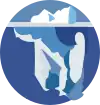Portal:Language

Introduction
.jpg.webp)



Language is a structured system of communication that consists of grammar and vocabulary. It is the primary means by which humans convey meaning, both in spoken and written forms, and may also be conveyed through sign languages. The vast majority of human languages have developed writing systems that allow for the recording and preservation of the sounds or signs of language. Human language is characterized by its cultural and historical diversity, with significant variations observed between cultures and across time. Human languages possess the properties of productivity and displacement, which enable the creation of an infinite number of sentences, and the ability to refer to objects, events, and ideas that are not immediately present in the discourse. The use of human language relies on social convention and is acquired through learning.
Estimates of the number of human languages in the world vary between 5,000 and 7,000. Precise estimates depend on an arbitrary distinction (dichotomy) established between languages and dialects. Natural languages are spoken, signed, or both; however, any language can be encoded into secondary media using auditory, visual, or tactile stimuli – for example, writing, whistling, signing, or braille. In other words, human language is modality-independent, but written or signed language is the way to inscribe or encode the natural human speech or gestures.
Depending on philosophical perspectives regarding the definition of language and meaning, when used as a general concept, "language" may refer to the cognitive ability to learn and use systems of complex communication, or to describe the set of rules that makes up these systems, or the set of utterances that can be produced from those rules. All languages rely on the process of semiosis to relate signs to particular meanings. Oral, manual and tactile languages contain a phonological system that governs how symbols are used to form sequences known as words or morphemes, and a syntactic system that governs how words and morphemes are combined to form phrases and utterances.
The scientific study of language is called linguistics. Critical examinations of languages, such as philosophy of language, the relationships between language and thought, how words represent experience, etc., have been debated at least since Gorgias and Plato in ancient Greek civilization. Thinkers such as Jean-Jacques Rousseau (1712–1778) have argued that language originated from emotions, while others like Immanuel Kant (1724–1804) have argued that languages originated from rational and logical thought. Twentieth century philosophers such as Ludwig Wittgenstein (1889–1951) argued that philosophy is really the study of language itself. Major figures in contemporary linguistics of these times include Ferdinand de Saussure and Noam Chomsky. (Full article...)
Selected language -
 Location map of Aruba, Bonaire, and Curaçao, where Papiamento is spoken |
Papiamento (English: /ˌpɑːpiəˈmɛntoʊ/) or Papiamentu (English: /ˌpɑːpiəˈmɛntuː/; Dutch: Papiaments) is a Portuguese-based creole language spoken in the Dutch Caribbean. It is the most widely spoken language on the Caribbean ABC islands (Aruba, Bonaire, Curaçao), with official status in Aruba and Curaçao. Papiamento is also a recognised language in the Dutch public bodies of Sint-Eustatius and Saba.
The language, spelled Papiamento in Aruba and Papiamentu in Bonaire and Curaçao, is largely based on colonial-era Portuguese and Spanish (including Judaeo-Portuguese), and has been influenced considerably by Dutch and Venezuelan Spanish. Due to lexical similarities between Spanish and Portuguese, it is difficult to pinpoint the exact origin of some words. Though there are different theories about its origins, most linguists now believe that Papiamento emerged from the Spanish and Portuguese creole languages that developed in the West African coasts, as it has many similarities with Cape Verdean Creole and Guinea-Bissau Creole. (Full article...)Did you know (auto-generated)
- ... that Jean-Claude Corbeil was credited with having "de-anglicized Quebec" during his time as linguistic director of the province's language police?
- ... that Arithmetic was the first mathematics text book written in the Russian language?
- ... that Andanappa Doddameti was the first member to address the Bombay Legislative Assembly in the Kannada language?
- ... that Australia has three major Japanese language schools?
- ... that after visiting Hungary in 2015, members of Action Deaf Youth headed to Stormont to demand better sign language support in Northern Ireland?
- ... that the Swiss Youth Symphony Orchestra was founded in 1969 for members from all four Swiss language regions, and meets twice a year for rehearsals and a tour program?
More did you know -
- ...that most of the 8,000 speakers of the Niuean language live outside the borders of Niue?
- ...that hundreds of words still in use today, including accident, cinnamon, desk, scissors, vacation, and Valentine, first appear in manuscripts written by Geoffrey Chaucer in the 1300s?
- ...that the Jru' language, an indigenous language of Laos, was once written in a secret script?
- ...that during the filming of The Linguists in the Andes, the cast coped with altitude sickness by drinking coca leaf tea?
Categories
Linguistics: Computational linguistics • Grammar • Historical linguistics • Morphology • Phonetics • Phonology • Pragmatics • Reading • Semantics • Sociolinguistics • Syntax • Writing
Languages: Language families • Pidgins and creoles • Sign languages
Linguists: By nationality • Historical linguists • Morphologists • Phoneticians • Phonologists • Sociolinguists • Syntacticians • Translators
Stubs: Constructed languages • Languages • Linguists • Pidgins and creoles • Typography • Vocabulary and usage • Writing systems
Full Language category tree |
|---|
|
Select [►] to view subcategories
Language Languages Outlines of languages Language acquisition Language-related awards Language competitions Natural language and computing Language in fiction Language games Gender in language Language identifiers Language interpretation Language comparison Language movements Language reform Linguistics Language mechanics Language and mysticism Oral communication Philology Philosophy of language Language policy Self-reference Sign language Sociology of language Language software Speech Speech and language pathology Statements Terminology Vocabulary Works about language Writing Language stubs |
Related portals
Selected topic -

Yue (Cantonese pronunciation: [jyːt̚˨]) is a group of similar Sinitic languages spoken in Southern China, particularly in Liangguang (the Guangdong and Guangxi provinces).
The name Cantonese is often used for the whole group, but linguists prefer to reserve that name for the variety used in Guangzhou (Canton), Wuzhou (Ngchow), Hong Kong and Macau, which is the prestige dialect. Taishanese, from the coastal area of Jiangmen (Kongmoon) located southwest of Guangzhou, was the language of most of the 19th-century emigrants from Guangdong to Southeast Asia and North America. Most later migrants have been speakers of Cantonese. (Full article...)Selected picture -

Geographical distribution of the preferential use of the terms castellano (Castilian), in red, vs. español (Spanish), in blue, to refer to the Spanish language
Language News
- 16 March 2023 –
- The Moldovan parliament approves a law that formally declares the country's official language as Romanian. (Reuters)
- 14 March 2023 – Timeline of artificial intelligence
- OpenAI launches GPT-4, the next generation large language model for artificial intelligence chatbot ChatGPT. The new model can respond to images, and has the ability to process up to 25,000 words. (BBC News)
- 17 February 2023 – Russia–South Africa relations, China–South Africa relations
- The South African Navy hosts a ten-day joint military exercise in the Indian Ocean with Russia and China. The exercise is named "Mosi II" after the Tswana word for "smoke". (BBC News) (DW)
Topics
Languages of Africa: Arabic, Chadic, Cushitic, Kanuri, Maasai, Setswana, Swahili, Turkana, Xhosa, Yoruba, Zulu, more...
Languages of the Americas: Aleut, Carib, Cherokee, Inuktitut, Iroquois, Kootenai, Mayan, Nahuatl, Navajo, Quechuan, Salish, American Sign Language, more...
Languages of Asia: Arabic, Assamese, Balochi, Bengali, Chinese, Japanese, Hajong, Hebrew, Hindustani, Kannada, Kokborok, Marathi, Khasi, Korean, Kurdish, Malayalam, Manipuri, Meithei, Mongolian, Persian, Rajasthani, Sindhi, Sanskrit, Sylheti, Tamil, Tanchangya, Tulu, Telugu, Tibetan, Thai, Turkish, Vietnamese, Khowar, more...
Languages of Austronesia: Austric, Fijian, Hawaiian, Javanese, Malagasy, Malay, Maori, Marshallese, Samoan, Tahitian, Tagalog, Tongan, Auslan, more...
Languages of Europe: Basque, Czech, Danish, Dutch, English (book), French, German, Greek, Italian, Latin, Leonese, Norwegian, Polish, Portuguese, Romanian, Russian, Slovak, Spanish, Ukrainian more...
Constructed languages: Esperanto, Ido, Volapük, more...
Agglutinative language, Analytic language, Constructed language, Creole, Context-free language, Extinct language, Dialect, Fusional language, Inflectional language, International language, Isolating language, Language isolate, National language, Natural language, Pidgin, Pluricentric language, Polysynthetic language, Proto-language, Sign language, Spoken language, Synthetic language, Variety (linguistics)

Applied linguistics, Cognitive linguistics, Accent (dialect), Computational linguistics, Descriptive linguistics, Eurolinguistics, Generative linguistics, Historical linguistics, Lexicology, Lexical semantics, Morphology, Onomasiology, Phonetics, Phonology, Pragmatics, Prescription, Prototype semantics, Psycholinguistics, Semantics, Stylistics, Sociolinguistics, Syntax
See also: List of linguists

Alphabets: Arabic alphabet, Bengali alphabet, Cyrillic alphabet, Hebrew alphabet, Latin alphabet, more...
Other writing systems: Abjad, Abugida, Braille, Hieroglyphics, Logogram, Syllabary, SignWriting, more..
See also: History of the alphabet, Script
Associated Wikimedia
The following Wikimedia Foundation sister projects provide more on this subject:
-
 Commons
Commons
Free media repository -
 Wikibooks
Wikibooks
Free textbooks and manuals -
 Wikidata
Wikidata
Free knowledge base -
 Wikinews
Wikinews
Free-content news -
 Wikiquote
Wikiquote
Collection of quotations -
 Wikisource
Wikisource
Free-content library -
 Wikiversity
Wikiversity
Free learning tools -
 Wiktionary
Wiktionary
Dictionary and thesaurus
Find a language
| Enter an ISO 639 code to find the corresponding language article |
-
 List of all portalsList of all portals
List of all portalsList of all portals -
 The arts portal
The arts portal -
 Biography portal
Biography portal -
 Current events portal
Current events portal -
 Geography portal
Geography portal -
 History portal
History portal -
 Mathematics portal
Mathematics portal -
 Science portal
Science portal -
 Society portal
Society portal -
 Technology portal
Technology portal -
 Random portalRandom portal
Random portalRandom portal -
 WikiProject PortalsWikiProject Portals
WikiProject PortalsWikiProject Portals